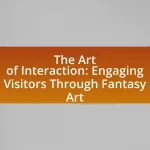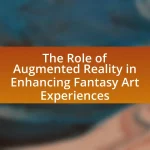The article examines the evolution of fantasy art, tracing its development from traditional forms such as paintings and illustrations to modern interactive mediums like video games and virtual reality. It highlights key historical milestones, including the influence of mythology and the impact of digital technology on artistic expression. The discussion encompasses the defining characteristics of traditional fantasy art, the role of cultural influences, and the significance of interactive elements in enhancing storytelling. Additionally, it addresses the differences between traditional and digital techniques, the importance of technology in the creative process, and best practices for artists to remain relevant in the evolving landscape of fantasy art.
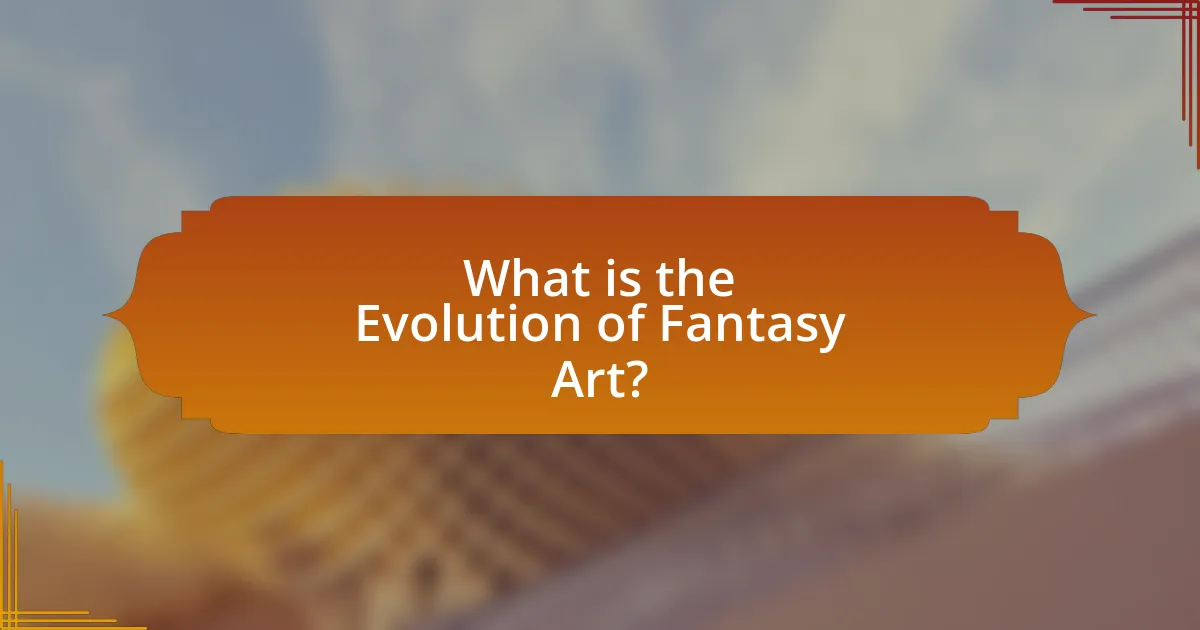
What is the Evolution of Fantasy Art?
The evolution of fantasy art encompasses a transition from traditional forms, such as paintings and illustrations, to modern interactive mediums like video games and virtual reality. Initially, fantasy art was heavily influenced by mythology and folklore, with artists like Gustave Doré in the 19th century creating detailed illustrations for literary works. The 20th century saw the rise of fantasy art in popular culture, particularly through the works of artists like Frank Frazetta and Boris Vallejo, who popularized the genre in magazines and book covers.
With the advent of digital technology in the late 20th century, fantasy art began to incorporate computer-generated imagery, allowing for more dynamic and immersive experiences. This shift was further accelerated by the gaming industry, where artists create expansive worlds and characters, exemplified by franchises like “Final Fantasy” and “World of Warcraft.” Today, fantasy art continues to evolve, integrating augmented reality and interactive storytelling, reflecting the ongoing interplay between technology and artistic expression.
How has fantasy art changed over time?
Fantasy art has evolved significantly over time, transitioning from traditional forms to interactive digital mediums. Initially, fantasy art was predominantly characterized by illustrations in books and paintings, with artists like Arthur Rackham and Frank Frazetta defining the genre through detailed, imaginative depictions of mythical creatures and epic landscapes. The introduction of digital technology in the late 20th century revolutionized the field, allowing artists to create more dynamic and immersive works. Today, fantasy art encompasses a wide range of formats, including video games and virtual reality experiences, which engage audiences in interactive storytelling. This shift reflects broader technological advancements and changing consumer preferences, as seen in the rise of franchises like “World of Warcraft” and “The Elder Scrolls,” which blend art with gameplay, creating a participatory experience for fans.
What are the key historical milestones in fantasy art?
Key historical milestones in fantasy art include the emergence of Romanticism in the 19th century, which emphasized imagination and the supernatural, exemplified by artists like Gustave Doré. The 20th century saw the rise of pulp magazine illustrations, where artists such as Frank Frazetta popularized fantasy imagery. The advent of digital art in the late 20th century revolutionized the field, allowing for new techniques and broader accessibility, with artists like H.R. Giger influencing both fantasy and science fiction. Additionally, the integration of fantasy art into video games and films in the 21st century, such as the works of artists for franchises like “The Lord of the Rings,” marked a significant evolution in the medium, blending traditional artistry with interactive experiences.
How did cultural influences shape the evolution of fantasy art?
Cultural influences significantly shaped the evolution of fantasy art by integrating diverse mythologies, folklore, and artistic traditions into its visual narratives. For instance, the Romantic movement in the 19th century emphasized emotion and nature, leading artists like Gustave Moreau to incorporate elements of mythology and dreamlike imagery, which became foundational in fantasy art. Additionally, the rise of global communication in the 20th century allowed for cross-cultural exchanges, as seen in the incorporation of Eastern aesthetics in Western fantasy art, exemplified by artists like Yoshitaka Amano, who blended Japanese art styles with Western fantasy themes. This fusion of cultural elements not only enriched the visual language of fantasy art but also expanded its thematic depth, reflecting a broader range of human experiences and beliefs.
What are the defining characteristics of traditional fantasy art?
Traditional fantasy art is characterized by its imaginative and often mythical themes, vibrant colors, and detailed depictions of fantastical creatures and landscapes. This genre typically features elements such as dragons, wizards, and enchanted forests, which are rooted in folklore and mythology. The use of rich textures and intricate details enhances the otherworldly atmosphere, allowing viewers to immerse themselves in the depicted scenes. Historically, traditional fantasy art has been influenced by various artistic movements, including Romanticism and Symbolism, which emphasize emotion and the sublime. Notable artists like Arthur Rackham and Frank Frazetta have contributed significantly to the genre, showcasing these defining characteristics through their iconic works.
What techniques and mediums were commonly used in traditional fantasy art?
Traditional fantasy art commonly utilized techniques such as oil painting, watercolor, and ink drawing, alongside mediums like canvas, paper, and wood panels. Oil painting was favored for its rich colors and blending capabilities, allowing artists to create detailed and vibrant scenes. Watercolor provided a translucent quality, ideal for ethereal landscapes and delicate figures. Ink drawing, often used for illustrations, enabled precise line work and intricate details. These techniques and mediums were essential in conveying the imaginative and otherworldly themes characteristic of fantasy art, as seen in the works of artists like Frank Frazetta and Boris Vallejo, who employed these methods to bring fantastical worlds to life.
How did traditional fantasy art reflect societal values and beliefs?
Traditional fantasy art reflected societal values and beliefs by visually representing the cultural narratives, moral lessons, and mythologies prevalent in a given society. For instance, during the Middle Ages, fantasy art often depicted religious themes and allegories, illustrating the importance of faith and the divine in everyday life, as seen in works like the illuminated manuscripts that combined biblical stories with intricate illustrations. Additionally, the Renaissance period showcased humanism through fantasy art, emphasizing individualism and the beauty of the human form, as evidenced by artists like Botticelli, whose works celebrated both mythology and human experience. These artistic expressions served not only as entertainment but also as a means to communicate and reinforce the prevailing ideologies and ethical standards of their time.
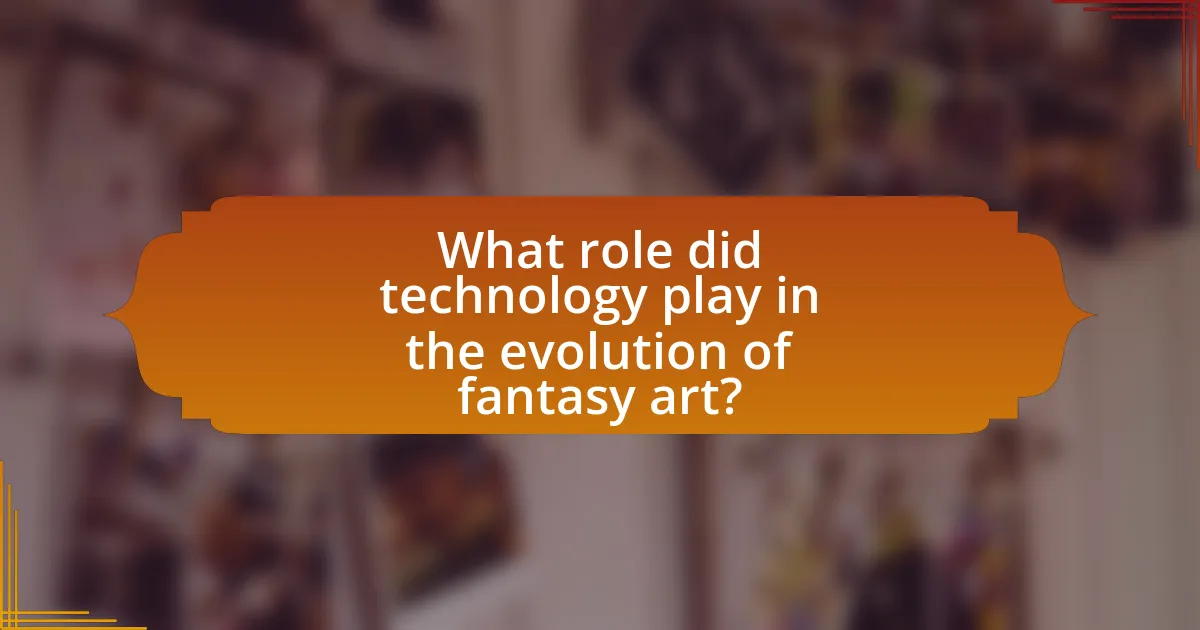
What role did technology play in the evolution of fantasy art?
Technology has been pivotal in the evolution of fantasy art by enabling artists to create more intricate and immersive works. The advent of digital tools, such as graphic design software and 3D modeling programs, has allowed artists to experiment with new styles and techniques that were not possible with traditional media. For instance, the introduction of Adobe Photoshop in the early 1990s revolutionized digital painting, providing artists with a versatile platform to manipulate images and create detailed fantasy landscapes. Additionally, advancements in hardware, such as graphic tablets, have facilitated a more intuitive drawing experience, allowing for greater precision and creativity. The rise of online platforms has also expanded the reach of fantasy art, enabling artists to share their work globally and collaborate with others, further enriching the genre.
How did the advent of digital tools impact fantasy art creation?
The advent of digital tools significantly transformed fantasy art creation by enhancing accessibility, efficiency, and creative possibilities for artists. Digital software such as Adobe Photoshop and Corel Painter allows artists to experiment with various styles and techniques without the limitations of traditional media, enabling rapid iterations and modifications. Additionally, the rise of digital platforms has democratized art creation, allowing a broader range of artists to share their work globally, as evidenced by the proliferation of online art communities and marketplaces. This shift has led to an increase in diverse artistic expressions and collaborations, further enriching the fantasy art genre.
What are the most significant digital tools used by fantasy artists today?
The most significant digital tools used by fantasy artists today include Adobe Photoshop, Corel Painter, and Procreate. Adobe Photoshop is widely recognized for its extensive features that allow artists to create detailed digital paintings and illustrations, making it a staple in the industry. Corel Painter offers a natural painting experience with its realistic brush simulations, appealing to artists who prefer a traditional painting feel in a digital format. Procreate, popular among iPad users, provides a user-friendly interface and powerful tools for sketching and painting on the go. These tools are essential for modern fantasy artists, enabling them to produce high-quality artwork efficiently.
How has digital art changed the accessibility of fantasy art?
Digital art has significantly increased the accessibility of fantasy art by allowing artists to create and share their work more easily and affordably. Traditional art methods often require expensive materials and physical space, while digital platforms enable artists to produce high-quality artwork using software on personal devices. This shift has democratized the creation process, allowing a broader range of individuals, regardless of financial means or geographic location, to participate in fantasy art. For instance, platforms like DeviantArt and ArtStation provide artists with the ability to showcase their work globally, reaching audiences that were previously inaccessible. Additionally, the rise of social media has facilitated instant sharing and feedback, further enhancing community engagement and collaboration among artists and fans.
What are the differences between traditional and digital fantasy art?
Traditional fantasy art primarily utilizes physical mediums such as paint, pencil, or ink on surfaces like canvas or paper, while digital fantasy art employs software and digital tools to create images on electronic devices. Traditional art often emphasizes texture and the tactile experience of materials, whereas digital art allows for greater flexibility, ease of editing, and the ability to incorporate various effects that are difficult to achieve in traditional mediums. Additionally, traditional art is typically a one-of-a-kind piece, while digital art can be easily reproduced and shared across multiple platforms, enhancing accessibility and distribution.
How do the artistic processes differ between traditional and digital mediums?
Artistic processes in traditional and digital mediums differ primarily in their tools and techniques. Traditional mediums, such as painting and drawing, rely on physical materials like canvas, paint, and brushes, which require manual skill and often involve a linear progression from sketch to final piece. In contrast, digital mediums utilize software and hardware, allowing for non-linear workflows, easy corrections, and the ability to manipulate layers and effects instantaneously.
For example, traditional artists must wait for paint to dry before adding layers, while digital artists can work on multiple layers simultaneously without such constraints. This flexibility in digital art enables experimentation and rapid iteration, which is less feasible in traditional methods. Additionally, digital art can incorporate elements like animation and interactivity, expanding the creative possibilities beyond static images.
What are the advantages and disadvantages of each medium?
Traditional mediums, such as painting and drawing, offer advantages like rich texture and depth, allowing for unique artistic expression and a tangible connection to the artwork. However, they can be limited by physical materials and require significant time investment. Digital mediums provide advantages such as ease of editing, accessibility, and the ability to create complex effects quickly, but they may lack the tactile quality and emotional depth often found in traditional art. Interactive mediums, like video games and virtual reality, engage audiences in immersive experiences, fostering deeper emotional connections, yet they can be resource-intensive and may require technical skills that not all artists possess.
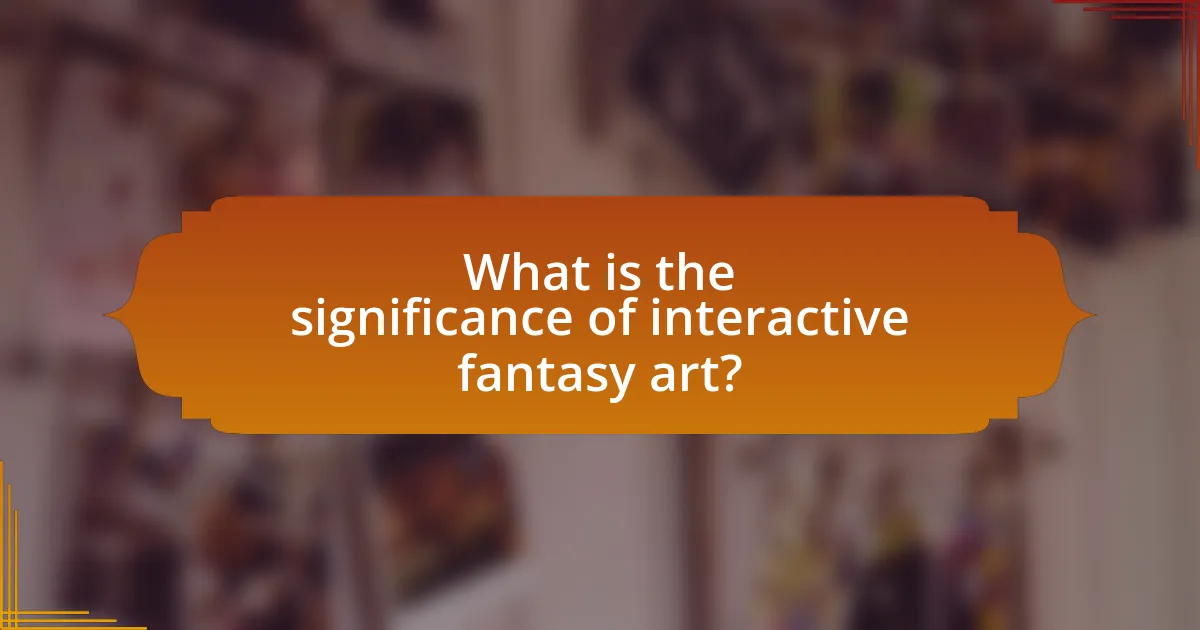
What is the significance of interactive fantasy art?
Interactive fantasy art is significant because it enhances user engagement and immersion, allowing audiences to actively participate in the narrative and visual experience. This form of art transforms passive observation into an interactive journey, where viewers can influence outcomes and explore dynamic environments. Studies have shown that interactive experiences can increase emotional investment and retention of information, making the art more impactful. For instance, video games and virtual reality applications have demonstrated that users are more likely to remember and connect with stories when they can interact with the characters and settings, as evidenced by research from the University of Southern California, which highlights the cognitive benefits of interactive storytelling.
How has interactive technology transformed the experience of fantasy art?
Interactive technology has significantly transformed the experience of fantasy art by enabling immersive engagement and dynamic storytelling. This transformation is evident through the use of virtual reality (VR) and augmented reality (AR), which allow viewers to step into fantastical worlds and interact with characters and environments in real-time. For instance, platforms like Oculus Rift and applications such as Tilt Brush have empowered artists to create three-dimensional art that users can explore from multiple angles, enhancing the depth of experience. Additionally, interactive installations at exhibitions have allowed audiences to influence the artwork through their actions, creating a personalized narrative that evolves based on user input. This shift from passive observation to active participation has fundamentally changed how audiences perceive and connect with fantasy art, making it a more engaging and memorable experience.
What are the key features of interactive fantasy art?
Interactive fantasy art is characterized by its immersive engagement, allowing viewers to participate in the artwork through various interactive elements. Key features include dynamic storytelling, where narratives evolve based on user choices; responsive visuals that change in reaction to user input; and multi-sensory experiences that incorporate sound, movement, and touch. These elements enhance user agency and emotional connection, making the experience unique for each participant. The integration of technology, such as augmented reality and virtual reality, further enriches the interactive aspect, enabling deeper exploration of fantastical worlds.
How do interactive elements enhance storytelling in fantasy art?
Interactive elements enhance storytelling in fantasy art by allowing viewers to engage with the narrative actively, creating a more immersive experience. This engagement can take various forms, such as clickable elements, animations, or virtual reality components, which invite the audience to explore different facets of the story at their own pace. Research indicates that interactive storytelling can increase emotional investment and retention of information, as users are more likely to remember experiences they actively participated in compared to passive observation. For instance, studies show that interactive media can lead to a 30% increase in user engagement and a 50% improvement in narrative retention compared to traditional formats. Thus, the incorporation of interactive elements in fantasy art not only enriches the storytelling experience but also enhances the audience’s connection to the narrative.
What are some examples of successful interactive fantasy art projects?
Some examples of successful interactive fantasy art projects include “Journey,” “Shadow of the Colossus,” and “The Night Cafe.” “Journey,” developed by Thatgamecompany, allows players to explore a vast desert landscape, engaging with other players in a unique, wordless narrative experience. “Shadow of the Colossus,” created by Team Ico, combines breathtaking visuals with interactive gameplay, where players must defeat giant creatures in a hauntingly beautiful world. “The Night Cafe,” inspired by Vincent van Gogh’s artwork, offers an immersive virtual reality experience where users can explore and interact with the environment, bringing the artist’s vision to life. These projects exemplify the successful integration of interactivity and fantasy art, showcasing innovative storytelling and artistic expression.
How have video games influenced the evolution of fantasy art?
Video games have significantly influenced the evolution of fantasy art by introducing interactive elements and immersive storytelling that expand the visual and thematic boundaries of the genre. The rise of 3D graphics technology in the 1990s, exemplified by titles like “Final Fantasy VII,” allowed artists to create more complex and detailed worlds, which in turn inspired traditional fantasy artists to adopt similar techniques and aesthetics. Additionally, the popularity of video games has led to a greater demand for high-quality artwork, prompting collaborations between game developers and established fantasy artists, such as the partnership between Wizards of the Coast and renowned illustrators for the “Magic: The Gathering” card game. This synergy has resulted in a cross-pollination of styles and ideas, ultimately enriching the visual language of fantasy art across various media.
What role do virtual and augmented reality play in interactive fantasy art?
Virtual and augmented reality significantly enhance interactive fantasy art by creating immersive experiences that engage users in a three-dimensional space. These technologies allow artists to construct environments where viewers can explore and interact with fantasy elements in real-time, fostering a deeper emotional connection to the artwork. For instance, platforms like Oculus Rift and Microsoft HoloLens enable users to step into fantastical worlds, interact with characters, and manipulate objects, which traditional art forms cannot achieve. This interactivity not only transforms the viewer’s role from passive observer to active participant but also expands the narrative possibilities within fantasy art, as users can influence storylines and outcomes through their actions.
What are best practices for creating engaging fantasy art today?
To create engaging fantasy art today, artists should focus on strong storytelling, dynamic compositions, and effective use of color and light. Strong storytelling involves crafting a narrative that resonates with viewers, allowing them to connect emotionally with the artwork. Dynamic compositions draw the eye and create a sense of movement, which can enhance the viewer’s experience. Effective use of color and light can evoke specific moods and highlight important elements within the piece.
Research indicates that artworks with clear narratives and emotional depth tend to engage audiences more effectively, as seen in studies on viewer interaction with visual art. Additionally, the integration of digital tools and techniques allows for greater experimentation and innovation, further enhancing the engagement factor in fantasy art.
How can artists effectively blend traditional and digital techniques?
Artists can effectively blend traditional and digital techniques by integrating physical media with digital tools throughout their creative process. For instance, an artist may start with hand-drawn sketches or paintings, then scan these images into a digital format for further manipulation using software like Adobe Photoshop or Procreate. This method allows for the preservation of the unique textures and nuances of traditional art while leveraging the versatility and efficiency of digital platforms.
Additionally, artists can utilize digital layers to enhance their traditional work, enabling them to experiment with colors, effects, and compositions without compromising the original piece. This approach has been validated by numerous contemporary artists who have successfully merged these techniques, demonstrating that the combination can lead to innovative and dynamic artworks that appeal to a broader audience.
What tips can help artists stay relevant in the evolving fantasy art landscape?
Artists can stay relevant in the evolving fantasy art landscape by continuously adapting their skills and embracing new technologies. This includes learning digital art techniques, utilizing software like Adobe Photoshop or Procreate, and exploring 3D modeling tools such as Blender. Engaging with online platforms and communities, such as social media and art forums, allows artists to showcase their work, receive feedback, and stay informed about industry trends. Additionally, collaborating with other artists and participating in art challenges can foster creativity and innovation. Research indicates that artists who actively engage with their audience and adapt to technological advancements are more likely to maintain relevance in their field.

